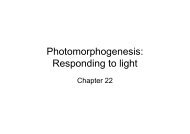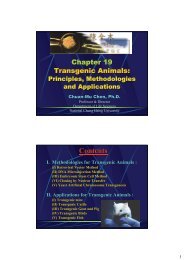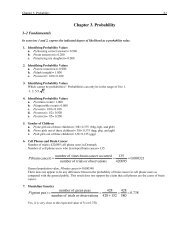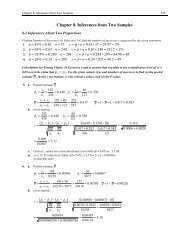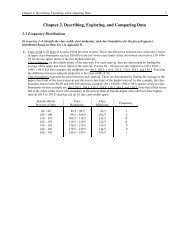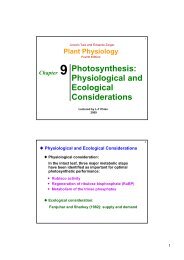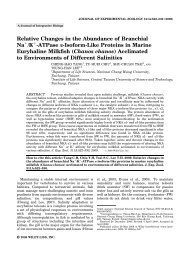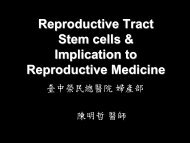Chapter 7. Hypothesis Testing with One Sample
Chapter 7. Hypothesis Testing with One Sample
Chapter 7. Hypothesis Testing with One Sample
Create successful ePaper yourself
Turn your PDF publications into a flip-book with our unique Google optimized e-Paper software.
<strong>Chapter</strong> 7: <strong>Hypothesis</strong> <strong>Testing</strong> <strong>with</strong> <strong>One</strong> <strong>Sample</strong> 209The claim is that the majority of smokers who try to quit <strong>with</strong> nicotine patch therapy are smoking one yearafter the treatment, so this is a right-tailed test. In the sample, 39 were smoking one year after treatment. Thesample proportion is p ˆ = x / n = 39 /71 = 0.549.H 0 : p = 0.50H 1 : p > 0.50The test statistic is z = p ˆ − p 0.549 − 0.50= = 0.826pq 0.50 × 0.50n 71In a right-tailed test at the 0.10 significance level, the critical value is z α= z .10= 1.28.Since this is a right tailed test, the P-value is the area to the right of the test statistic. Using Table A-2, we findthat the P − value = (1 − 0.7967) = 0.2033.We fail to reject the null hypothesis.There is not sufficient sample evidence to support the claim that the majority of smokers who try to quit <strong>with</strong>nicotine patch therapy are smoking one year after the treatment. Although a majority return to smoking oneyear after the treatment, this does not mean the treatment is ineffective. To be certain, the rate at which thetherapy patients return to smoking should be compared to others who have quit smoking.12. Smoking and College EducationFirst, we check the requirements. The sample is a random sample. The conditions for a binomial are satisfied.The sample size is 785 <strong>with</strong> the claim that the percentage of people <strong>with</strong> four years of college that smoke isless than 27%, making p = 0.27, so np = 785× 0.27 = 211.95 and nq = 785× 0.73 = 573.05. The requirementsare satisfied.The claim is that the percentage of people <strong>with</strong> four years of college that smoke is less than 27%, so this is aleft-tailed test. In the sample, 144 subjects <strong>with</strong> four years of college education smoked. The sample proportionis p ˆ = x / n = 144 /785 = 0.183.H 0 : p = 0.27H 1 : p < 0.27The test statistic is z = p ˆ − p =pqn0.183− 0.270.27 × 0.73785=−5.490In a left-tailed test at the 0.01 significance level, the critical value is −z α=−z .01=−2.33.Since this is a left tailed test, the P-value is the area to the left of the test statistic. Using Table A-2, we findthat the P − value = 0.0001.We reject the null hypothesis.The sample data support the claim that the percentage of people <strong>with</strong> four years of college that smoke is lessthan 27%. <strong>One</strong> reason that they may smoke at a lower rate is that they are better educated on the hazards anddangers.13. Drug <strong>Testing</strong> for Adverse ReactionsFirst, we check the requirements. The sample does not appear to be a simple random sample, but the subjectsmay comprise a random sample that is representative of the population. The conditions for a binomial aresatisfied. The sample size is 221 <strong>with</strong> the claim that the percentage of users who experience dizziness is lessthan 5%, making p = 0.05, so np = 221× 0.05 = 11.05 and nq = 221× 0.95 = 209.95. The requirements aresatisfied.The claim is that the percentage of users who experience dizziness is less than 5%, so this is a left-tailed test.As stated in the exercise, p ˆ = .032.H 0 : p = 0.05H 1 : p < 005The test statistic is z = p ˆ − p =pqn0.032 − 0.05=−1.2280.05× 0.95221




